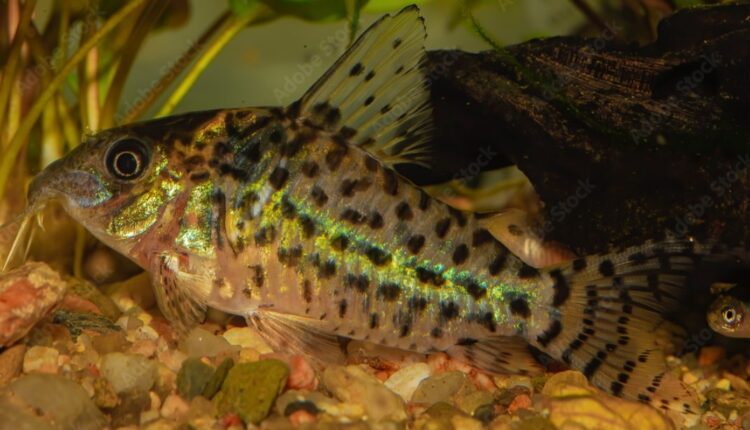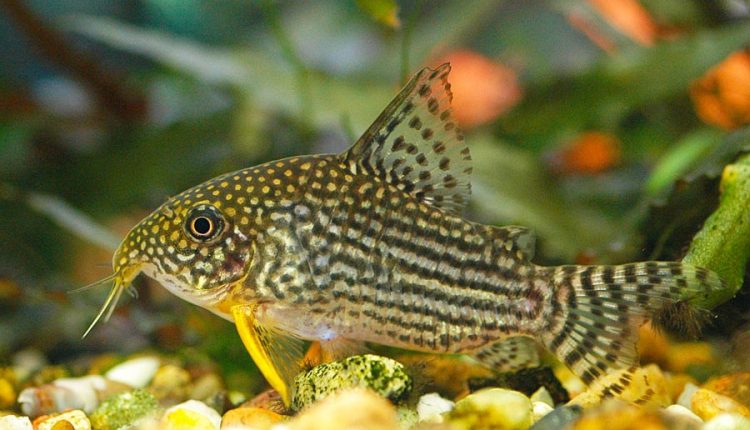Cory Catfish (Corydoras): Care, Breeding, Diet & Behavior

Cory Catfish are one of the most popular freshwater fish in the aquarium hobby.
These small, peaceful catfish come in a variety of colors and patterns that make them an attractive option for any tank.
Cory Catfish are great beginner fish because they tolerate water parameters well, can live peacefully with other species, and do not require large tanks to thrive.
However, there are some important things you should know before purchasing Cory Catfish, this care guide will help!
Cory Catfish Overview
| Family: | Callichthyidae |
| Origin: | South America |
| Temperament: | Peaceful |
| Size: | 2.5 inches |
| Minimum Tank Size: | 10 Gallons |
| Diet: | Omnivore |
| Care: | Easy |
| pH: | 6.0 – 8.0 |
| Alkalinity Levels: | 3-10 dKH |
| Temperature: | 70°F – 78°F |
About Cory Catfish
Cory Catfish Origin & Distribution
Cory Catfish originate from South America.
They are found in slow moving waters of the Amazon and Orinoco River basins, where they live among vegetation or at rocky bottoms.
These fish can be found throughout Venezuela, Columbia, Brazil, Peru and Ecuador-but are not native to most other countries!
Typical Behavior
Corey Catfish bottom-dwelling fish and are well known for being very peaceful community fish, which is the main reason they are so popular with aquarists.
They make excellent tank mates because they never attack other fish, and will hide when they feel threatened.
The only real time you will see them leave the bottom of the tank is when they swim to the surface of the water for air.
They are able to absorb oxygen from the air due to their adapted intestinal lining.
They are extremely active and often swim in schools-often with other species of Cory Catfish!
They will eat almost anything, so they can be a good addition to most tanks-just beware of small shrimp or snails.
Although a Cory can survive alone, it will be much happier if it can socialize with others of its kind.
Appearance
Corey Catfish have a short face with a wide mouth, big eyes and whiskers.
They have two barbels on their chin which help them to find food in the tank.
Their body is covered with armor plating called scutes that are firm at first but will soften when they mature into adults-this makes it easier for Cory Catfish to squeeze through tight spaces in your aquarium!
The colors of most Corys tend to be golden or dark brown with either lighter or darker spots all over their bodies.
They often change color depending on what substrate is beneath them (light sand = light color; black gravel = dark color).
The exception to this rule seems to be young specimens who are patternless until around six months old when they begin developing spots.
Cory Catfish Size
Corey are small fish with an average size of 2.5 inches for most Corey species. Some can be as large as 4 inches and can also be as small as just over an inch.
Cory Catfish Lifespan
In the wild, the Corey Catfish will live between 5 – 7 years, but in good conditions they can live 20 plus years in captivity.
Cory Catfish Types
Albino Cory Catfish
The albino Cory catfish is a type of Cory cat that has no pigment in its skin, and comes from the peppered Cory.
Panda Cory Catfish
The black patches around the eyes of the panda cory catfish earned it its name, and they also have a white or orange background that reflects green.
Green Cory Catfish
The green Corey Catfish are active in the aquarium, and available in black, green, bronze, and albino.
Peppered Cory Catfish
The peppered cory is a popular aquarium fish that is also known as the spotted catfish.
Long-finned or albino versions are also available. They’re bronze with black patches on their bodies.
Pygmy Cory Catfish
The Pygmy remain at 1 inch long and are the smallest of the Corydoras.
They do better in lower light, and will need to be fed smaller meals.
Julii Cory Catfish
The Julii cory catfish are a hard species to find. The Julii are usually peaceful fish that can do well in schools of their own kind or other species.
Emerald Cory Catfish
Emerald Cory Catfish are a beautiful variety that is gaining popularity in the aquarium trade, and are green with pink highlights underneath.
Sterbai Cory Catfish
The Sterbai cory is a lovely creature with yellow undersides and rings around its eyes, giving it a distinct appeal.
Tank Setup & Requirements
Cory fish require warm waters of around 70-78°F as they are tropical fish and this will match their natural environment.
It’s also important to make sure that this temperature stays consistent. If you’re not trying to stimulate breeding, dramatic changes to the temperature can result in stress.
- Water Temperature: Between 70°F-78°F
- pH Levels: 6.0-8.0
- Alkalinity Levels: 3-10 dKH
It’s a good idea to test the water regularly as stress levels can increase if levels of nitrate are high.
One way of reducing nitrate is to conduct partial water changes.
They dislike fast-moving water and would rather swim in streams and inlets where they are protected from it.
What Size Aquarium Do They Need?
They may live in as little as a 10-gallon tank, but if you want to keep many species or larger shoals, they will require a lot more space.
It’s best to go with a 15-gallon tank, and make sure 2 to 4 gallons of water is added per additional cory.
Filtration
A hang on back filter is the best option for this fish.
The filter hose should be covered with a sponge pre-filter to keep these fish from getting sucked into it and injured or killed, while still allowing plenty of water flow through the unit.
Another option is a canister filter.
Heater
A heater is an essential piece of equipment to keep your aquarium stable.
Lighting
Corys are adaptable to a wide range of light conditions, but they prefer the dimmer surroundings of their natural habitats.
LED lighting is ideal because your plants will need sufficient lighting.
Substrate
The substrate is one of the most crucial components in any Cory catfish tank.
Corys are unusual in that, unlike most freshwater fish, they don’t do well with gravel. The jagged edges might harm the fins and stomach of these fish.
The best option is to go with a soft, sand substrate that isn’t going to damage or hurt these fish.
Plants & Decorations
Plants are a great idea as they will break the flow of water, oxygenating the water, and provide cover.
Here are some ideal plants you can use:
- Anubias Nana
- Amazon swords
- Java Fern
- Crypts
- Pennywort
- Dwarf hairgrass
- Hornwort
- Java Moss
Other
As Cory Catfish have a habit of jumping to the surface of the water for air, you may consider an aquarium cover.
Cory Catfish Common Diseases
Cory Catfish are susceptible to many diseases, but most can be avoided with proper care.
Here are some common Cory Catfish Diseases:
Ich: Ich is a common disease for fish, and is caused by the parasite Ichthyophthirius. It presents itself with small white spots all over your Cory Catfish’s body which will turn black within a day or two.
Nitrite Poisoning: If you see Corydoras swimming up or moving slowly in your aquarium, they might be poisoned by nitrite.
Dropsy: Dropsy can be deadly, but it can also be cured if caught in time! Dropsy is indicated when scales are raised
Fungal Infections: Fungal infections occur when the water is dirty or not cleanable. Make sure you have a good filter and change out 25% of your tank’s water weekly, even if it doesn’t need changing yet!
Swim Bladder Disease: Cory cat fish that have swim bladder disease will float upside down or lie on their sides at the bottom of your aquarium for no reason.
The cause is unknown, but may be caused by parasites in underweight specimens which causes an obstruction in protein metabolism, preventing them from digesting food properly causing malnutrition.
Cory Catfish Tank Mates
As Corey Catfish are very a very peaceful breed, they will get along with pretty much any species of fish that doesn’t try to eat them.
Here are some suitable options:
- Mollies
- Fancy Guppies
- Platies
- Swordtails
- Neon Tetras
- Angelfish
- Danios
- Gouramis
Breeds to avoid putting with Corey fish:
Keeping Cory Catfish Together
At least six should be kept together as they are schooling fish.
What Do Cory Catfish Eat?
In their native habitat, Cory catfish will eat just about any food that is available, and usually scavenge the substrate. for small insects, worms, and larvae.
Their staple diet in the aquarium should include:
- Sinking catfish pellets and flakes (they will also eat algae wafers)
- Live or frozen brine shrimp, daphnia, tubifex worms and bloodworms
Once a day, feed your fish only as much as they can consume in 5 minutes. Remove the leftovers promptly after feeding.
Also, keep in mind that Corydoras can consume other fish species’ tiny eggs from time to time!
Breeding Cory Catfish
Providing you have a good tank setup, breeding Cory Catfish is pretty easy. The breeding process can be done in two different ways. Let’s take a look at both.
Option 1: Dedicated Breeding Tank
This method involves placing a breeding pair of Corydoras in their own tank.
The reason for this is to make sure the young fry have a safe environment and will not be eaten by other fish or older, larger cory catfish from pondering how delicious they might look!
When the pair have spawned, you should return both adults back into their regular tank. The fry will be left in the breeding tank.
Option 2: Dedicated Fry Tank
Instead of placing a breeding pair into a separate tank, this method involves spawning the fish in the main tank, and then removing the eggs and placing them into the fry tank.
This method is more convenient and less stressful for the adult fish; nevertheless, the fry may have a poorer chance of survival because they are not in isolation.
The Spawning Process
Feed your Corydoras several tiny meals a day with a high-protein diet that includes live or frozen foods as well as wonderful prepared flakes or pellets to stimulate spawning.
The females should visibly show they are carrying eggs after a week or two.
Cory Catfish Conclusion
Cory Catfish are a great beginner fish for fresh water aquariums.
They can be found in pet stores and online, but it’s important to do your research before you buy one because they require specific care.
You will need a tank that is at least 10 gallons, but 15 gallons or larger is better.
It’s also imperative that you provide them with hiding places like caves or decorations where they can rest when not eating!

